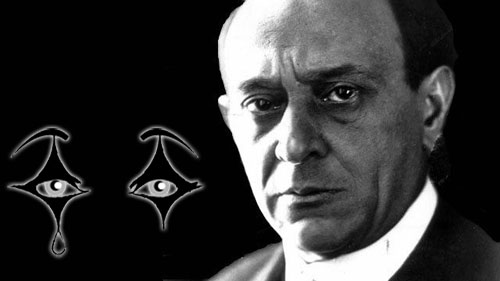Pierrot Lunaire 100 years later by Emmanuelle Piedboeuf
/ October 1, 2012
Version française...
Flash version here.

Arnold Schoenberg’s Pierrot Lunaire turns 100 this year: on October 16, 1912, the work was heard publicly for the first time, in Berlin. A turning point in the history of music, the piece is of a genre that never leaves anyone indifferent. In celebration of its centennial, it is time to revisit this pillar of modern music.
In 1912, shortly after the creation of Pierrot, a journalist wrote in the Revue française de musique that “the moment has not yet come, for us at least, to write an objective article on Arnold Schoenberg’s work.” A hot topic for critics, Schoenberg’s music became subject for debate in the whole of Europe, having overturned established principles and replaced them with something completely new. Today, a century after Pierrot Lunaire, we are able to take a more enlightened look at the work of a composer who made one of the greatest marks on the 20th century. Although Schoenberg’s music can be divided into periods, what is known as his “expressionist” work takes its inspiration from pictorial art. Born in Munich in the period preceding World War I, the expressionist movement dwelled on conveying “harmful” emotions. It centered on artists Franz Marc and Wassily Kandinsky, who later became members of Der Blaue Reiter (The Blue Rider). Fascinated by Kandinsky’s work, Schoenberg attempted some amateur painting, and his music was greatly influenced by the group’s theories. Several of his pre-war works, such as Erwartung (1909), Die glückliche Hand (1913) and Pierrot Lunaire (1912) can be qualified as expressionist. Many of his students also adhered to the movement, among them Alban Berg.
No character was better suited to fulfill the expressionist mission than Pierrot. Famous in the Commedia dell’arte, Pierrot gradually lost his buffoonish appearance in the 19th century, transforming into a morbid and androgynous silhouette. At the same time as the character of Pierrot was metamorphosing in the art world, a Jean-Martin Charcot was made head of nervous system diseases at the Salpêtrière Hospital in Paris. An influential visionary, he organized conferences and distributed photographs of “hysterical” patients mid-crisis. Hysteria became a high-profile topic and rapidly gained the attention of the art world. Many plays were staged about a crazy, hysterical Pierrot, further contributing to the transformation of his image.
Schoenberg did not escape this trend: the text by Giraud on which he based his piece is full of references to the illness (epilepsy) that was still not well understood at the time. These references include calling on the Madonna of hysteria, “mother of all sorrows,” in the first part of the text. Schoenberg divided the text into three parts: Pierrot is first “moonstruck,” then caught in a nightmare, before returning to Bergamo.
Pierrot Lunaire was born from a commission. Just as Schoenberg was contemplating writing a melodrama, Albertine Zehme, a singer renowned for her poetic monologues, performed in cabarets, approached the composer regarding the creation of a work. This became Pierrot, made up of recited verses from Giraud’s poetry translated into German. After negotiation, the work consisted of twenty-one poems. Schoenberg accompanied the vocal line with a quintet played by a rotation of eight instruments—piano, piccolo, flute, clarinet, bass clarinet, violin, viola and cello.
A vocal technique called sprechstimme was used. In the preface to Pierrot, Schoenberg explains the technique: “The given melody in sprechstimme means that the notes are not to be sung... The task of the performer is to transform them into a spoken melody, taking into account the given height.”
An autodidact, Schoenberg never received any extensive musical education other than that provided by Zemlinsky, who eventually became his brother-in-law. Nonetheless, with Pierrot Lunaire, he once again proved that he was far from ignorant of musical tradition, having chosen traditional forms for his pieces and combined them with systematic atonality. Pierrot was of his last steps towards the dodecaphonic system, which he later developed. The work is therefore incredibly complex, both for musicians and audiences alike.
A century after Pierrot’s creation, Puccini’s prediction to Schoenberg that “this music may one day be accepted, while ours, made with a tonal system and chromatic superstructure, may become intolerable” may be on its way to becoming reality through contemporary music.
Translation: Catherine Hine
Version française... |
|


